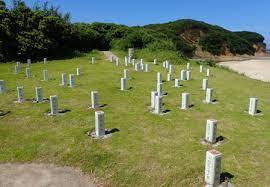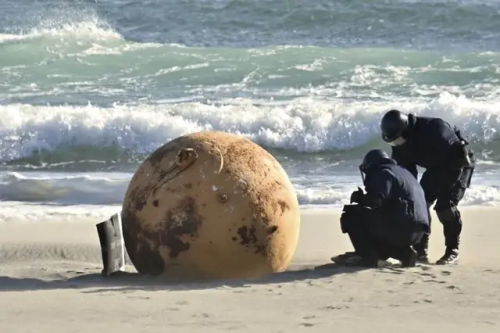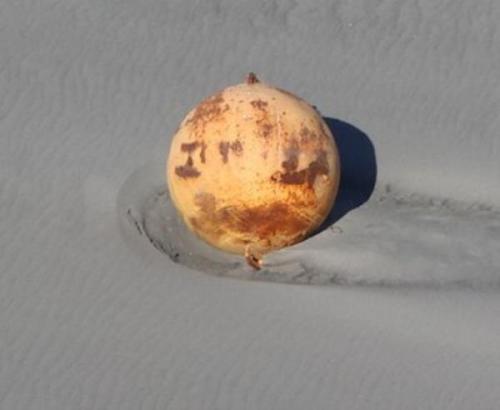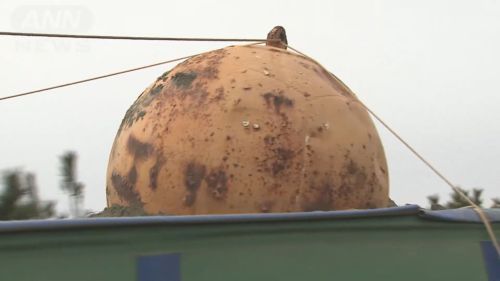Sean Bienvenidosfanaticosarqueológicos A Una Nueva Noticia Arqueológica Del País Del Sol Naciente

Sean bienvenidosfanaticosarqueológicos a una nueva noticia arqueológica del país del sol naciente ¿Dé que trata dicha noticia? Pues a continuación sin más demora os traigo un supernotición del periodo Asuka(592-710).
-
Se han descubierto unos restos arqueológicos que datan del año 650 hace unos 1300 años de antigüedad en la antigua ciudad de Asuka en la prefectura de Nara, para la próxima publicación hablaremos de las prefecturas, aunque sea un resumen.
-
¿Quién ha encontrado estos restos arqueológicos? Fueron encontrados por el Instituto Arqueológico de Kashihara del que ya hablaremos próximamente. ¿Cuál era el uso de este canal? Serviría para desviar el agua que se desbordaba para llenar el estanque que os dejaré una ilustración del mismo.
-
Las piedras tienen un diámetro de 6 metros, las cuales están pavimentadas. Desde luego una gran obra hidráulica para su época. - Os deseo un feliz día y nos vemos en próximas publicaciones un cordial saludo.
-
考古学ファンの皆様、日出ずる国からの新しい考古学ニュースへようこそ。このニュースは何についてのものですか? さて、早速、飛鳥時代(592年~710年)のスーパーニュースをお届けします。
-
古都奈良県の飛鳥市で約1300年前の650年頃の遺跡が発見されたが、次回はまとめではあるが都道府県の話をしたいと思う。 - 誰がこれらの遺跡を発見したのでしょうか? それらは橿原考古学研究所によって発見されました。これについては後ほど説明します。 このチャンネルの用途は何ですか? これは、溢れ出た水を池に流すのに役立ちます。その図を残しておきます。
-
直径6メートルの石が敷き詰められている。 確かに当時としては素晴らしい水圧作業でした。
-
幸せな一日をお祈りいたします。また今後の出版物でお会いしましょう。心からご挨拶申し上げます。
-


Welcome archaeological fans to a new archaeological news from the country of the rising sun. What is this news about? Well, without further delay, I bring you a super news from the Asuka period (592-710).
-
Archaeological remains dating back to the year 650, about 1,300 years ago, have been discovered in the ancient city of Asuka in Nara Prefecture. For the next publication we will talk about the prefectures, even if it is a summary.
-
Who found these archaeological remains? They were found by the Kashihara Archaeological Institute, which we will talk about soon. What was the use of this channel? It would serve to divert the water that was overflowing to fill the pond, which I will leave you with an illustration of.The stones have a diameter of 6 meters, which are paved. Certainly a great hydraulic work for its time.
-
I wish you a happy day and see you in future publications, cordial greetings.
More Posts from Noticiasarquelogicasjaponesas and Others




Sean bienvenidos, japonistasarqueológicos, a una nueva entrega de arqueología nipona, una vez dicho esto pónganse cómodos qué empezamos. - En esta ocasión vamos a hablar, de cómo se deformaba el cráneo de forma antropogénica en el sitio arqueológico de Hirota en Tanegashima, localizado en la prefectura de Kagoshima. El yacimiento data del periodo yayoi 400 al 250 d.c - La deformación craneal ya se daba en muchas culturas de América, con motivos religiosos y sociales y posiblemente aquí podremos hallar el mismo caso similar o parecido, al ser un hallazgo reciente todavía faltan muchos estudios para ello. ¿Qué opinan ustedes al respecto? ¿Conocían este lugar? - En el caso de las culturas Americanas, le ponían cuerdas para alargar el cráneo¿Practicaban las mismas actividades? Quien sabe lo que nos depara el futuro, esta publicación está hecha con intenciones científica-divulgativa para transmitir conocimiento al mundo. - Espero que os guste y nos vemos en próximas publicaciones, que pasen una buena semana.
-
Welcome, Japanese archaeologists, to a new installment of Japanese archaeology, having said that, make yourself comfortable and let's start.
-
On this occasion we are going to talk about how the skull was deformed in an anthropogenic way in the archaeological site of Hirota in Tanegashima, located in the Kagoshima prefecture. The site dates from the Yayoi period 400 to 250 AD
-
Cranial deformation already occurred in many cultures in America, for religious and social reasons and possibly here we can find the same or similar case, as it is a recent finding, many studies are still missing for it. What do you think about it? Did you know this place? - In the case of American cultures, they used ropes to lengthen the skull. Did they practice the same activities? Who knows what the future holds for us, this publication is made with scientific-informative intentions to transmit knowledge to the world. - I hope you like it and see you in future publications, have a good week.Welcome, Japanese archaeologists, to a new installment of Japanese archaeology, having said that, make yourself comfortable and let's start.
-
On this occasion we are going to talk about how the skull was deformed in an anthropogenic way in the archaeological site of Hirota in Tanegashima, located in the Kagoshima prefecture. The site dates from the Yayoi period 400 to 250 AD
-
Cranial deformation already occurred in many cultures in America, for religious and social reasons and possibly here we can find the same or similar case, as it is a recent finding, many studies are still missing for it. What do you think about it? Did you know this place?
-
In the case of American cultures, they used ropes to lengthen the skull. Did they practice the same activities? Who knows what the future holds for us, this publication is made with scientific-informative intentions to transmit knowledge to the world. - I hope you like it and see you in future publications, have a good week.
-
日本の考古学者の皆さん、日本の考古学の新しい記事へようこそ。そうは言っても、気を楽にして始めましょう。
-
今回は、鹿児島県種子島の広田遺跡で、人為的に頭蓋骨がどのように変形されたのかについてお話します。この遺跡は、弥生時代、西暦 400 年から 250 年に遡ります。 頭蓋骨の変形は、宗教的および社会的理由により、アメリカの多くの文化ですでに発生しており、おそらくここでも同じまたは類似の症例が見つかる可能性があります。これは最近の発見であるため、多くの研究がまだ不足しています。あなたはそれについてどう思いますか?この場所を知っていましたか? - アメリカ文化の場合、頭蓋骨を伸ばすためにロープを使用していましたが、同じ活動を行っていたのでしょうか?私たちの将来がどうなるかは誰にもわかりませんが、この出版物は、知識を世界に伝えるという科学的有益な意図を持って作成されています。
-
気に入っていただければ幸いです。今後の出版物でお会いできることを願っています。良い一週間をお過ごしください




Sean bienvenidos mis queridos fanáticosarqueológicos a una nueva entrega de prehistoria Japónesa en esta ocasión nos trasladamos a la pregunta ¿Cuándo se originó el sintoísmo?. - Aunque parezca raro es una religión que se conformo durante el periódo Jōmon (17.500-300), para ser exactos a finales de dicho período y continua hasta nuestros días los dioses del sintoísmo, se les llama Kamis ( dios) ya que para los japoneses todo tenía un dios las montañas, ríos. - El sintoísmo tiene influencias chinas, coreanas de hay que tenga similitudes con el taoísmo, ¿Qué dos libros recogen la categoría de los Kamis? Son el Kojiki(713d.c) y el Nihonshoki(720d.c). - Espero que os guste y nos vemos en una próxima públicacion un cordial saludo. 🇯🇵 私の愛する考古学ファンを日本の先史時代の新作に歓迎します。今回は、神道がいつ始まったのかという質問に移ります。 - 奇妙に思えるかもしれませんが、縄文時代(17500-300)に形成された宗教であり、正確にはその時代の終わりに、今日まで神道の神であり、カミス(神)と呼ばれています。 日本人にとって、山や川にはすべて神がいました。 - 神道は中国、韓国の影響を受けており、道教との類似点があります。 カミスのカテゴリーに分類される2冊の本は何ですか? こうじき(713d.c)と日本書紀(720d.c)です。 - よろしくお願いします。次の出版物で心からのご挨拶を申し上げます。 🇬🇧 Welcome my dear archaeological fans to a new installment of Japanese prehistory, this time we move to the question, when did Shintoism originate? - Although it may seem strange, it is a religion that was formed during the Jōmon period (17500-300), to be exact at the end of that period and continues to this day the gods of Shintoism, they are called Kamis (god) since for the Japanese everything the mountains and rivers had a god. - Shintoism has Chinese, Korean influences, and there are similarities with Taoism. What two books are classified under the category of the Kamis? They are the Kojiki (713d.c) and the Nihonshoki (720d.c). - I hope you like it and see you in a next publication a cordial greeting.

Capítulo 2: El camino hacia el enigma - Sean bienvenidos, japonistasarqueológicos, al siguiente capítulo de las ruinas Weda en el capítulo anterior estuvimos hablando de donde se localiza el asentamiento, cuáles son los ríos que lo rodean el emplazamiento, de cuando data el mismo y cuando se empezó a cultivarse el arroz. También comentamos que había misterios desde los periodos Yayoi tardío al Kofun, ya que había pocos asentamientos continuos, pero sí que hay del periodo Heian. - La primera prospección fue llevada a cabo en 2013, dichos resultados no arrojaron luz suficiente a los restos para una mayor comprensión del asunto expuesto. Habría que esperar a la segunda para qué arroja nuevas esperanzas, la cual se descubrieron restos de viviendas en foso del siglo IX d.c¿Qué se encontraron? Los restos que salieron fueron los siguientes: Un horno de herrería, con una estufa de cocina, ambos restos arqueológicos fueron tanto como un taller y una residencia. - También se encontró una fosa con una zanja que rodeaba el asentamiento, se ha excavado un producto de cobre con forma de pájaro la fecha y el propósito de su elaboración no está resuelto, todavía esperemos que próximos estudios arrojen luz a los restos y al yacimiento. - Espero que os haya gustado y nos vemos en próximas publicaciones de arqueología e historia de Japón. - 第2章:謎への道 - 日本の考古学者の皆さん、ウェダ遺跡の次の章へようこそ. 前の章では、集落がどこにあるのか、その場所を囲む川は何か、稲作が始まったのはいつから、いつ始まったのかについて話しました.弥生時代後期から古墳時代にかけての謎もあり、連続した集落は少ないが、平安時代のものはある。 - 最初の調査は 2013 年に実施されましたが、これらの結果は、露出した物質をよりよく理解するのに十分な光を遺物に当てはめませんでした。新たな希望を与えてくれる第二の発見を待つ必要があり、西暦 9 世紀の堀の住居跡が発見されました。出てきた遺跡は次のとおりです。 鍛冶屋のオーブン、キッチンストーブ、両方の考古学的遺跡はワークショップと住居の両方でした. - 集落を取り囲む溝付きの穴も発見され、鳥の形をした銅製品が発掘されましたが、その精緻化の年代と目的は解決されていません。とサイト。 - あなたがそれを気に入ってくれて、日本の考古学と歴史の将来の出版物でお会いできることを願っています. - Chapter 2: The path to the enigma - Welcome, Japanesearchaeologicalists, to the next chapter on the Weda ruins. In the previous chapter we were talking about where the settlement is located, what are the rivers that surround the site, when it dates back and when rice began to be cultivated. We also commented that there were mysteries from the late Yayoi to the Kofun periods, since there were few continuous settlements, but there are from the Heian period. - The first survey was carried out in 2013, these results did not shed enough light on the remains for a greater understanding of the matter exposed. We would have to wait for the second one to shed new hope, in which remains of moat dwellings from the 9th century AD were discovered. What were they found? The remains that emerged were the following: A blacksmith's oven, with a kitchen stove, both archaeological remains were both a workshop and a residence. - A grave with a ditch that surrounded the settlement was also found, a copper product in the shape of a bird has been excavated, the date and purpose of its production is not resolved, we still hope that future studies will shed light on the remains and the site. - I hope you liked it and see you in future publications on archeology and history of Japan.
ソース写真/source photo:https://naganomaibun.or.jp/research/east/和田遺跡・和田1号塚/




Sean bienvenidos japonistasarqueologicos a una nueva entrega, esta ocasión os hablaré del castillo de Takeda dicho esto pongase comodo que empezamos. - El castillo, se localiza en la ciudad de Asago, prefectura de Hyogo, data del siglo XV del periodo Muromachi, en este periodo podemos encontrar el clan del shogun Ashikaga, fue construido por Sozen Yamana, el daimyo de la provincia. - Entre sus Restos podemos encontrar : Muros de piedra, fosos, pozos , también fue escenario de la batalla entre el ejército de Hidenaga Hashiba y el ejército de Terunobu Otagaki. - ¿Dónde se localiza el castillo Takeda? Se localiza en el monte Kojo, Oda Nobunaga derrotó al castillo con su ejército en varias ocasiones en el siglo XVI, mientras que Hideyoshi Hashiba tomaba el castillo de Ueda, su hermano pequeño Hidenaga Hashiba condujo a 3000 soldados al castillo de Takeda y marchó desde el paso de Mayumi hasta Tajima , el 28 de octubre de 1600 el castillo takeda fue abandonado. - Espero que os haya gustado y nos vemos en próximas publicaciones de Japón que pasen una buena semana. - 日本の考古学者を歓迎します。今回は竹田城についてお話ししますので、楽にしていてください。 - 兵庫県朝来市にあるこの城は、15世紀の室町時代に遡り、この時代には将軍足利氏の一族を見出すことができ、県内大名の山名宗全が築城したものである。 - 羽柴秀長軍と太田垣輝信軍の戦いの舞台にもなった。 - 竹田城はどこにあるのですか?古城山に位置し、16世紀には織田信長が何度も軍を率いて城を破り、羽柴秀吉が上田城を手に入れる一方、弟の羽柴秀長が3000人の兵を率いて竹田城に入り、真弓峠から但馬に進軍、1600年10月28日に竹田城は放棄された。 - また、次の記事でお会いしましょう。 - Welcome Japanese archaeologists to a new installment, this time I will tell you about Takeda Castle, so make yourself comfortable and let's get started. - The castle, located in the city of Asago, Hyogo prefecture, dates back to the 15th century Muromachi period, in this period we can find the clan of the shogun Ashikaga, it was built by Sozen Yamana, the daimyo of the province. - Among its remains we can find: stone walls, moats, wells, it was also the scene of the battle between the army of Hidenaga Hashiba and the army of Terunobu Otagaki. - Where is Takeda Castle located? It is located on Mount Kojo, Oda Nobunaga defeated the castle with his army several times in the 16th century, while Hideyoshi Hashiba took Ueda castle, his younger brother Hidenaga Hashiba led 3000 soldiers to Takeda castle and marched from Mayumi pass to Tajima, on 28 October 1600 Takeda castle was abandoned. - I hope you liked it and see you in the next Japan posts have a nice week.
Tanque japonés, abatido por tropas norteamericanas, agosto del 42, guerra del Pacífico./Japanese tank, shot down by North American troops, August 42, Pacific War./米軍によって撃墜された日本の戦車(42年8月、太平洋戦争)。





Sean bienvenidos, japonistasarqueológicos, a una nueva entrega arqueológica en esta ocasión hablaremos de un túmulo funerario con forma de ojo de cerradura una vez dicho esto pónganse cómodos que empezamos. - El túmulo se localiza en la ciudad de Yokohama, en la prefectura de Kanagawa, en la región de Kantō, isla de Honshū. Se realizaron excavaciones en las Ruinas de Oikawa Isemiya que acompañan la construcción de la carretera de circunvalación de la Ruta Nacional 246 Atsugi Hadano Road. El túmulo funerario tiene forma de ojo de cerradura, data de alrededor de los siglos III al VII d.c y fue descubierto en la cuenca del río Ogino. - El túmulo funerario, con forma de ojo de cerradura, tiene unas dimensiones de 37 metros de largo y 21 metros de ancho. En el sitio se encontraron una losa y herramientas de piedra del período Kofun. En los alrededores se han encontrado los restos de una vivienda del período Jomon. - Espero que os haya gustado y nos vemos en próximas publicaciones que pasen una buena semana. Welcome, Japanese archaeologists, to a new archaeological instalment, this time we are going to talk about a burial mound in the shape of a keyhole, so make yourselves comfortable and let's get started. - The burial mound is located in the city of Yokohama, Kanagawa Prefecture, in the Kantō region of Honshū Island. Excavations were conducted at the Oikawa Isemiya Ruins accompanying the construction of the Atsugi Hadano Road 246 National Route 246 bypass. The burial mound is keyhole-shaped, dates from around the 3rd to 7th centuries AD, and was discovered in the Ogino River basin. - The burial mound, shaped like a keyhole, is 37 metres long and 21 metres wide. A stone slab and stone tools from the Kofun period were found at the site. The remains of a Jomon period dwelling were found nearby. - I hope you liked it and I will see you in future publications. Have a nice week. 日本の考古学者の皆さん、ようこそ考古学の新連載へ!今回は鍵穴の形をした古墳についてお話しします。 - 古墳は神奈川県横浜市、本州の関東地方にある。国道246号厚木秦野道路バイパスの建設に伴い、及川伊勢宮遺跡で発掘調査が行われた。荻野川流域で発見されたこの古墳は、紀元後3世紀から7世紀ごろのもので、鍵穴のような形をしている。 - 鍵穴のような形をした古墳は、長さ37メートル、幅21メートル。古墳時代の石板や石器が出土している。近くに縄文時代の住居跡が見つかった。 - お気に召していただけたなら幸いである。 それでは、よい一週間を。 -


Capítulo 2: El origen de un país y su prehistoria, un paseo por la historia del país del sol naciente. El Pleistoceno Sean bienvenidos, a una nueva serie, de arqueología prehistórica en esta ocasión, nos trasladamos al país del sol naciente. En el capítulo anterior, estuvimos dando una pequeña introducción, de la prehistoria nipona, ha llegado la hora de matizar más en profundidad cada apartado.
-
En este capítulo, nos vamos a centrar en el pleistoceno, para entender la evolución meteremos, algunos contextos del mundo para que puedan ir comprendiendo el pleistoceno japonés del resto del mundo. La prehistoria humana comienza hace unos 2,5 a 7 millones de años aproximadamente, los primeros homínidos, salieron de África, Como son el caso de: Homo neanderthalensis, Homo heidelbergensis, Homo ergaster entre otros homínidos.
-
Sabemos que los primeros homínidos, que salieron de la cuna de áfrica, fueron los homo habilis y erectus los cuales se fueron desplazando por los distintos continentes, pasando primero por la zona de la península del Sinaí y luego pasaron por el corredor siro palestino.
-
En el capítulo anterior, salió la pregunta¿Cómo llegaron los primeros homínidos al archipiélago? Llegaron hace unos 30.000 a 90.000 aproximadamente, han salido recientes estudios arqueológicos, en respecto a esta parte, la cual ya os la comentaré en una noticia arqueológica, ¿De qué medio disponían?, probablemente, a través de canoas o balsas llegando así a la zona de Okinawa, ¿Quiénes habitaban Japón cuando ellos llegaron?, pues los Ainu, ¿cuándo llegaron?, aproximadamente hace unos 110.000 y 10.000 años antes de cristo.
-
Este capítulo lo vamos a tener que ir dividiendo en partes para irlo trabajando poco a poco. Espero que os haya gustado y nos vemos en el siguiente capítulo. Un fuerte abrazo.





Sean bienvenidos japonítasarqueológicos, a una nueva novedad japonesa, que está dando la vuelta al mundo una vez dicho esto póngase cómodos que empezamos. - Del día 21 al 23 de febrero, en la playa de Enshu el distrito de Nishi, en la ciudad de Hamamatsu en la prefectura de Shizuoka. - La bola de hierro mide 1’5 metros de diámetro, el Interior es hueco por lo que no hay riesgo de explotar. - Espero que os haya gustado¿Qué opinan ustedes? Abro el debate, nos vemos en próximas publicaciones de Japón. - ようこそ 日本の考古学者の皆さん 世界に羽ばたく日本の新機軸をご覧ください と言うわけで 楽にしてください 始めましょう - 2月21日から23日まで、静岡県浜松市西区にある遠州灘海岸にて。 - 鉄球は直径1.5メートル、内部は空洞で爆発の心配はない。 - いかがでしたか、いかがでしたか。また、日本からの投稿でお会いしましょう。 - Welcome, Japanese archaeologists, to a new Japanese novelty, which is making its way around the world, and with that said, make yourselves comfortable and let's get started. - From the 21st to the 23rd of February, at Enshu Beach, Nishi District, Hamamatsu City, Shizuoka Prefecture. - The iron ball is 1.5 metres in diameter, the interior is hollow so there is no risk of exploding. - I hope you liked it. What do you think? I open the debate, see you in future posts from Japan.
-
 rfpreiwaphase liked this · 11 months ago
rfpreiwaphase liked this · 11 months ago -
 bear-pattern-hamster liked this · 1 year ago
bear-pattern-hamster liked this · 1 year ago -
 repera23 liked this · 1 year ago
repera23 liked this · 1 year ago -
 noticiasarquelogicasjaponesas reblogged this · 1 year ago
noticiasarquelogicasjaponesas reblogged this · 1 year ago -
 tomohirosibuyahappyanimals liked this · 1 year ago
tomohirosibuyahappyanimals liked this · 1 year ago -
 margocooper liked this · 1 year ago
margocooper liked this · 1 year ago -
 u-nobu liked this · 1 year ago
u-nobu liked this · 1 year ago -
 rodolfo9999 liked this · 1 year ago
rodolfo9999 liked this · 1 year ago -
 keisukeoouchi liked this · 1 year ago
keisukeoouchi liked this · 1 year ago -
 ted-blogs-blog liked this · 1 year ago
ted-blogs-blog liked this · 1 year ago -
 asiaphotostudio liked this · 1 year ago
asiaphotostudio liked this · 1 year ago -
 burubonk liked this · 1 year ago
burubonk liked this · 1 year ago -
 hiromusicarts-blog liked this · 1 year ago
hiromusicarts-blog liked this · 1 year ago -
 noticiasarquelogicasjaponesas reblogged this · 1 year ago
noticiasarquelogicasjaponesas reblogged this · 1 year ago

238 posts



















